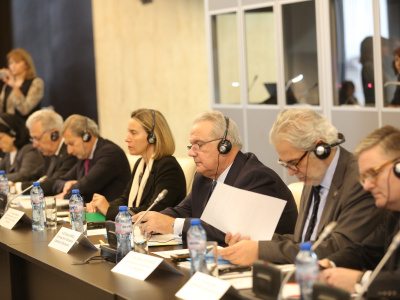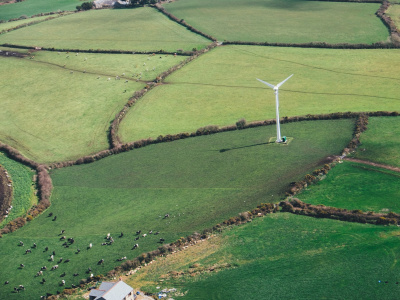
EU financing and private investments: Time for a quantum leap
Negotiations on the future of the EU finances post-2020 are a unique occasion to reconsider the financial instruments of the European Union, for both internal and external actions. They are also a chance to address more systemic issues. In a turbulent world, with the EU in need of new momentum, this window of opportunity should not be wasted. In particular, it is time to rethink how grants, and more generally public finance, can better stimulate investment (inside and outside the EU) for sustainable and inclusive growth. And in doing so, how leveraged finance can contribute to and be accompanied by efforts to improve an enabling environment and sustainable ecosystem. These were the underlying themes of two events I contributed to last week.
#MFF: Doing more with less
Focusing on the EU financial instruments in the next multi-annual EU budget, the Brussels’ event organised by the European Investment Bank stimulated a debate on “doing more with less”. From a public finance perspective, one of the challenges of the EU is to do more and better, on a tight budget, in a post-Brexit EU27. The current process of redefining the next Multiannual Financial Framework (MFF) is therefore not only about agreeing on priorities and budget allocation, but also about simplifying and rationalising the EU financial apparatus, in and off budget (think ‘Trust Funds’ for instance), with the idea to promote greater effectiveness and flexibility. This is a European process that also has its own internal political economy dynamics, where interests can drive outcomes more than considerations on greater strategy, effectiveness and flexibility. Yet, the potential is there. While I was at this event my colleague Andrew Sherriff was at the European Parliament giving evidence on the next MFF. There, Christian Leffler, the Deputy Secretary-General of the EEAS interestingly noted that one of the key lessons for the next MFF was,”[by looking at the] EIP, and the EFSD we will need to see how we include more effectively this economic dimension into our programmes through new and innovative modalities.” So, there is some indication that this issue is being considered.
#PF4SDG and blended finance
This issue of how to better leverage private finance for sustainable development goals (PF4SDG) was the focus of the second event (and following consultation meeting) at the OECD. The discussion focused on ways to increase the volume of finance for development, scaling up the leveraging of private finance, in an attempt to move from the billions to the trillions of dollars of sustainable investment necessary to achieve the SDGs. There are numerous interesting initiatives, notably by multilateral development banks (MDBs) and development finance institutions (DFIs), including with the provisions of much-needed guarantee mechanisms, but there is a need to go beyond the current model.
My take is that not enough efforts are made to attract institutional financiers (pensions and insurances), to understand and address their concerns (regulatory constraints were commonly mentioned), and to provide the appropriate financial vehicles to attract more passive investors that may contribute to the SDGs. Funds of funds (as in the Boost Africa initiative of the EIB, AfDB and EC), portfolio and co-lending approaches (as in the Managed Co-Lending Portfolio Program (MCPP) of the IFC for instance) and opening public development finance instruments capital to institutional and other private investors, potentially as equity investors or even shareholders, should be more systematically pursued. This may also require some more systemic reforms from MDBs, including in their board structure, as eloquently argued by Nancy Lee and by her CGD colleague Mark Plant.
But it is not only the volume of finance that matters. It is mainly the quality of investment, and the impact it can have on structural transformation, the SDGs, social and environmental sustainability, gender and inequality. This requires first and foremost to start from local dynamics and priorities, better-supporting project preparation, market and institutional development and governance enhancement. The contribution of the OECD, which at the event launched its insightful new report on Making Blended Finance Work for the Sustainable Development Goals, is also very useful in that respect. So are the five OECD DAC blended finance principles for unlocking commercial finance for the SDGs: (1) anchor blended finance use to a development rationale, (2) design blended finance to increase the mobilisation of commercial finance principle, (3) tailor blended finance to local context, (4) focus on effective partnering for blended finance, and (5) monitor blended finance for transparency and results.
The EU is well equipped to take up these challenges. The External Investment Plan provides a strong push to improve leverage (with risk-mitigation mechanisms), quality and impact of development finance in a more coherent and integrated manner, with a strong emphasis on fragile and poorer countries (more on this soon from ECDPM). The proposal by the EIB to create a subsidiary for its activities outside the EU paves the way towards a potentially highly innovative development bank model for the EU (another issue ECDPM will dwell with). Such endeavours should strongly build on private finance dynamics and potential and be strongly guided by SDGs agenda and OECD-type of principles. Most of all, they should build on local dynamics and initiatives, to accompany and support them, instead of seeking to drive them. Far from tedious technical considerations, finance might be a catalyst for more strategic approaches to inclusive and sustainable development, outside and inside the EU.
The views expressed are those of the author and not necessarily those of ECDPM.




